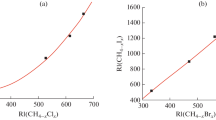Abstract
Retention indices were evaluated for one hundred most commonly reported essential oil compounds in gas chromatography (GC) using a large retention index database. Retention data are presented for three types of stationary phases: dimethyl silicone, dimethyl silicone with 5% phenyl groups, and polyethylene glycol stationary phases. The data evaluations are based on the treatment of multiple measurements with the number of data records ranging between 30 and 470 per compound. Data distribution analysis was limited to temperature programming conditions. Data reported include the most probable value of retention index, average and median values, standard deviation, and confidence intervals. The values of most probable retention indices correspond to frequently used GC conditions of measurements (temperature program, column parameters, gas flow conditions). The results are compared with data from several available retention index collections.






Similar content being viewed by others
References
Adams RP (2007) Identification of essential oil components by gas chromatography/mass spectrometry, 4th edn. Allured Publ., Carol Stream
Merfort I (2002) J Chromatogr A 967:115–130. doi:10.1016/S0021-9673(01)01560-6
Jennings WG, Shibamoto T (1980) Quantitative analysis of flavor and fragrance volatiles by glass capillary GC. Academic Press, New York
Klassen JK, Stein SE, Zenkevich IG (2000) In: Abstracts of 23rd international symposium on capillary chromatography. Rep. A18 (CD-ROM), Riva del Garda, Italy
Babushok VI, Linstrom PJ, Reed JJ, Zenkevich IG, Brown RL, Mallard WG et al (2007) J Chromatogr A 1157:414–421. doi:10.1016/j.chroma.2007.05.044
Stein SE, Babushok VI, Brown RL, Linstrom PJ (2007) J Chem Inf Model 47:975–980. doi:10.1021/ci600548y
Zenkevich IG, Babushok VI, Linstrom PJ, Stein SE (2005) Misidentified compounds found in the creation of comprehensive collection of retention indices. In: Abstracts of 28th international symposium on capillary chromatography. NV, CD-ROM, Las Vegas (paper in preparation)
Acree TE, Arn H (2004) Flavornet. Cornell University, NY (http://www.flavornet.org; and previous web-edition)
Cheong WJ (2002) Bull Korean Chem Soc 23:459–468
Zenkevich IG (1996) J Anal Chem 51:1041–1048 (in Russian)
Zenkevich IG (1996) Plant Resour 34:48–58 (in Russian)
Ardrey RE, Moffat AC (1981) J Chromatogr 220:195–252. doi:10.1016/S0021-9673(00)81925-1
Ramsey JD, Lee TD, Osselton MD, Moffat AC (1980) J Chromatogr 184:185–206. doi:10.1016/S0021-9673(00)85641-1
Gas Chromatographic Retention Indices of Toxicologically Relevant Substances on Packed or Capillary Columns with dimethylsilicone Stationary Phases. Report XVIII of the DFG Commission for Clinical-Toxicological Analysis (1992) 3rd edn, VCH
Moffat AC (1975) J Chromatogr 113:69–95. doi:10.1016/S0021-9673(00)88799-3
van den Dool H, Kratz PD (1963) J Chromatogr 11:463–471. doi:10.1016/S0021-9673(01)80947-X
Vigdergauz MS, Martynov AA (1971) Chromatographia 4:463–467. doi:10.1007/BF02268816
Sojak L, Vigdergauz MS (1978) J Cromatogr 148:159–167
Mitra GD (1981) J Chromatogr 211:239–242. doi:10.1016/S0021-9673(00)88039-5
Sojak L (2004) Petrol Coal 46(3):1–35
The Sadtler Standard Gas Chromatography Retention Index Library (1986) Sadtler Division, Bio-Rad Laboratories, vol 1–4, Philadelphia, PA
Bianchi F, Careri M, Mangia A, Musci M (2007) J Sep Sci 30:563–572. doi:10.1002/jssc.200600393
Shimazaki H, Shinomoto S (2007) Neural Comput 19:1503–1527. doi:10.1162/neco.2007.19.6.1503
Shimazaki H, Shinomoto S (2007) Adv Neural Inf Process Syst 19:1289–1296
Scott DW (1979) Biometrica 66:605–610. doi:10.1093/biomet/66.3.605
Linstrom PJ, Mallard WG (2008) NIST chemistry WebBook. NIST standard reference database number 69, September 2008. National Institute of Standards and Technology, Gaithersburg, MD 20899. http://webbook.nist.gov/chemistry
Ausloos P, Clifton CL, Lias SG, Mikaya AI, Stein SE, Tchekhovskoi DV et al (1999) J Am Soc Mass Spectrom. 10:287–299 (NIST Standard Reference Database 1A. NIST/EPA/NIH Mass Spectral Library with Search Program. Data Version NIST 05:2008
Baser KHC, Ozek G, Ozek T, Duran A (2006) Flavour Fragr J 21:568–570. doi:10.1002/ffj.1620
Demirci B, Baser KHC, Tabanca N, Wedge DE (2006) J Agric Food Chem 54:3146–3150. doi:10.1021/jf053222v
Tabanca N, Demirci B, Kirimer N, Baser KHC, Bedir E, Khand IA et al (2005) J Chromatogr A 1097:192–198. doi:10.1016/j.chroma.2005.10.047
Acknowledgment
We would like to acknowledge the large contribution of P. J. Linstrom in RI data handling using the NIST database.
Author information
Authors and Affiliations
Corresponding author
Additional information
We dedicate this work to the 50th anniversary of the publication of the article by E. sz. Kováts (Helv. Chim. Acta, 41:1915–1932, 1958) in which the retention index was introduced for the first time.
Rights and permissions
About this article
Cite this article
Babushok, V.I., Zenkevich, I.G. Retention Indices for Most Frequently Reported Essential Oil Compounds in GC. Chroma 69, 257–269 (2009). https://doi.org/10.1365/s10337-008-0872-3
Received:
Revised:
Accepted:
Published:
Issue Date:
DOI: https://doi.org/10.1365/s10337-008-0872-3



